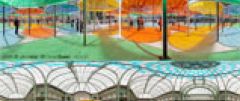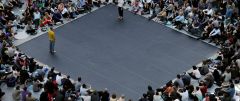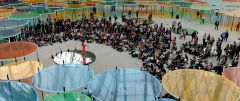Revelation
Revelation is one of the stakes in Daniel Buren’s art – not a revelation in the mystic or prophetic sense, or a claim to absolute truth, but a critical, reasonable revelation. The sort of revelation brought about by optical instruments: a different way of seeing, the sight of something not previously perceived or a glimpse of the invisible. Taken as a whole, Daniel Buren’s art can be regarded as “a tool for seeing,” a tool put at the spectator’s disposal.
In his first fly postings in the late 1960s he sought to expose the unspoken and/or unconscious rules that govern sight, the conditions for art’s visibility and the false assumptions about what an artist does. He developed these ideas later when he was officially invited to various institutions.
His pieces reveal hidden constraints: “It is not because the constraints cannot be seen at first glance that they don’t exist. A lot of the work I do is designed to flush them out, then if possible to expose them publicly.”
When he acts on an environment or a specific site, his intervention brings out forgotten or unsuspected elements: the basement of the Palais Royal and the convexity of its courtyard were revealed by The Two Plateaux, for example. With each piece, he offers an opportunity to learn to look and a broadening of the visual field.
For each site Buren invents new ways to reveal things, usually a device in which the only fixed element is the visual tool, the 8.7 cm wide stripes, an instrument of measurement, rhythm and revelation. A sign that has become a signature, or at least an indication of an investigation to be carried out.





